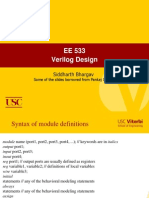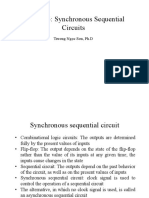0% found this document useful (0 votes)
5 views50 pagesVerilog Sequential
The document provides an overview of Verilog basics, including module definition, sequential logic, combinational design, and finite state machines. It covers key concepts such as defining modules, using bitwise operators, conditional assignments, and number representation in Verilog. Additionally, it explains sequential statements, always blocks, and examples of D flip-flops and latches.
Uploaded by
Saiteja GandepalliCopyright
© © All Rights Reserved
We take content rights seriously. If you suspect this is your content, claim it here.
Available Formats
Download as PDF, TXT or read online on Scribd
0% found this document useful (0 votes)
5 views50 pagesVerilog Sequential
The document provides an overview of Verilog basics, including module definition, sequential logic, combinational design, and finite state machines. It covers key concepts such as defining modules, using bitwise operators, conditional assignments, and number representation in Verilog. Additionally, it explains sequential statements, always blocks, and examples of D flip-flops and latches.
Uploaded by
Saiteja GandepalliCopyright
© © All Rights Reserved
We take content rights seriously. If you suspect this is your content, claim it here.
Available Formats
Download as PDF, TXT or read online on Scribd
/ 50



















































































